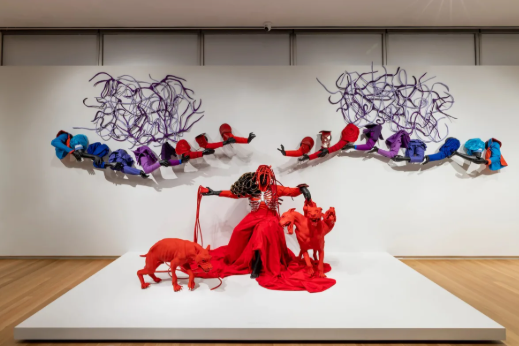
Mary Sibande is a South African visual artist and sculptor. She is known for large-scale sculptures and installations that explore identity, race, and gender. Her work combines historical memory with personal and cultural narratives. Sibande uses her art to confront apartheid history and social inequality through symbolic and striking imagery.
Early Life
Mary Sibande was born in 1982 in Barberton, Mpumalanga, South Africa. She grew up during the final years of apartheid. Her mother worked as a domestic worker, an experience that influenced Sibande’s art. She studied fine arts at the University of Pretoria, focusing on sculpture and installation.
Her early exposure to domestic labor and societal roles shaped her artistic vision.
Artistic Beginnings
Sibande started creating sculptures that explore the lives of women in South Africa. Her early works focused on domestic workers, history, and identity. She gained recognition for combining traditional sculpture with contemporary narrative. Her use of life-sized figures, vibrant colors, and detailed costumes became a signature style.
Major Works
-
Sophie Series (2000s–present) – Life-sized sculptures representing domestic workers transforming into powerful figures.
-
Long Live the Dead Queen (2008) – Explores post-apartheid identity and empowerment.
-
The Purple Shall Govern (2010) – Large installation addressing race, memory, and transformation.
-
The Elevator Series (2014) – Explores social mobility and personal aspiration.
-
I Am… Series (2016–present) – Portraits and sculptures exploring selfhood and heritage.
-
Life-sized installations in international exhibitions – Exhibited globally in museums and galleries.
Sophie Series (2000s–present)
Sibande’s most recognized work. It features a domestic worker named Sophie who transforms into a regal figure. The series confronts the legacy of apartheid, servitude, and gender inequality. It combines sculpture, costumes, and narrative storytelling.
Long Live the Dead Queen (2008)
Explores the concept of post-apartheid empowerment and memory. Sibande challenges stereotypes through symbolic imagery and theatrical presentation. It emphasizes dignity, resilience, and transformation.
The Purple Shall Govern (2010)
A large-scale installation exploring race, social hierarchy, and identity. The work uses color, scale, and costume to convey historical and cultural messages. It highlights Sibande’s ability to merge art with social commentary.
What Makes Her Different
-
Creates life-sized, detailed sculptures and installations.
-
Explores race, gender, identity, and historical memory.
-
Combines traditional sculpture techniques with conceptual and narrative art.
-
Internationally recognized for both visual impact and social meaning.
-
Works are visually striking, symbolic, and emotionally powerful.
Sibande’s art tells personal and collective South African stories.
Who Experiences Her Work
-
Art collectors and enthusiasts globally.
-
Students and scholars of visual arts, African studies, and gender studies.
-
Museum-goers and festival audiences interested in socially engaged art.
-
Audiences exploring post-apartheid identity, history, and empowerment.
Her installations resonate with both academic and general audiences.
Collaborations and Influence
-
Exhibited in major museums worldwide, including Tate Modern, Smithsonian, and Johannesburg Art Gallery.
-
Collaborates with curators and cultural organizations to promote African art.
-
Mentors emerging South African artists and sculptors.
Sibande bridges art, history, and social activism.
Activism and Cultural Role
Her work addresses gender, race, and historical inequality in South Africa. She highlights the experiences of domestic workers and marginalized communities. Through art, she encourages reflection on identity, empowerment, and social justice. Sibande contributes to South African culture by reclaiming history and telling untold stories.
Later Years and Legacy
Mary Sibande continues to create sculptures and installations internationally. Her works have been exhibited in Europe, North America, and Africa. She is recognized as a leading South African contemporary artist. Her art is studied in universities and displayed in major museums globally.
Legacy highlights:
-
Pioneer in figurative and narrative sculpture.
-
Influencer in contemporary African visual arts.
-
Chronicler of South African history, gender, and identity.
-
Mentor and inspiration for emerging South African artists.
Words
Mary Sibande is more than a sculptor. She is a visual storyteller and social commentator. Her art captures identity, history, and transformation. It combines beauty, symbolism, and social consciousness.
For anyone exploring South African contemporary art, sculpture, or post-apartheid identity, Mary Sibande is essential viewing and study.
Leave a Reply